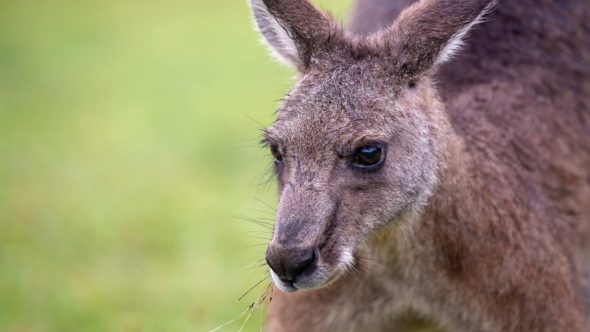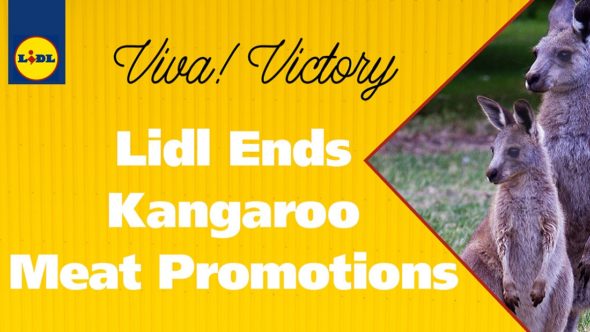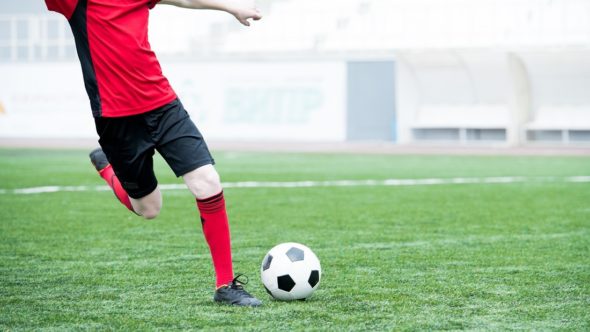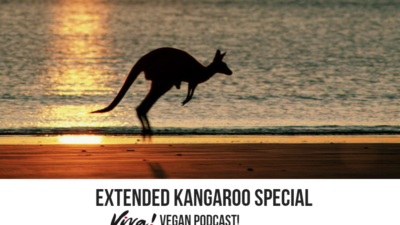How Kangaroos Are Farmed and Killed
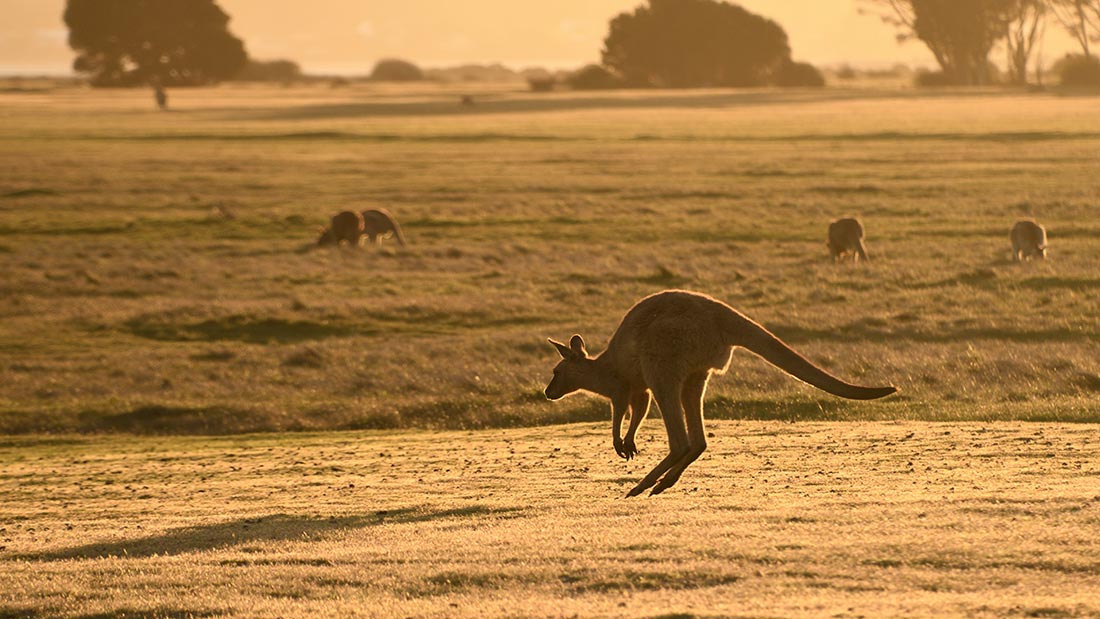
-
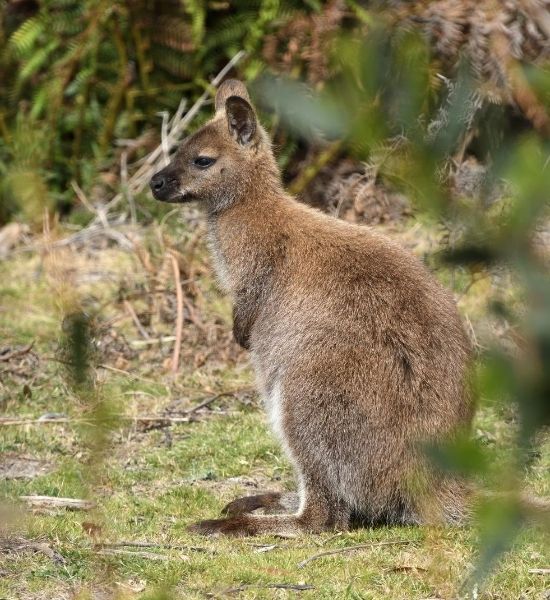
Photo by Ed Shephard
Kangaroos are indigenous to Australia, New Guinea and surrounding islands and belong to the Macropodidae family, meaning ‘big-footed’, which includes kangaroos, wallaroos, wallabies, hare-wallabies, nail-tail wallabies, rock-wallabies, pademelons, quokka, tree-kangaroos and the swamp wallaby1Humne, I. D., Jarman, P. J., Renfree, M. B. and Temple-Smith, P. D., 1989. ‘29. Macropodidae’, in Walton, D. W. and Richardson, B. J. (ed.) Fauna of Australia – Volume 1B Mammalia. Canberra: AGPS, pp 3. Available at https://www.environment.gov.au/system/files/pages/a117ced5-9a94-4586-afdb-1f333618e1e3/files/29-ind.pdf [Accessed 01 April 2020].
- There are four species of ‘great kangaroos’, red being the largest, growing up to two metres tall, eastern grey, western grey and wallaroo. They inhabit a wide range of environments, from high alpine regions to coastal forests and deserts2Wilson, D.E., Reeder, D.M. (eds.), 2005. Mammal Species of the World: A Taxonomic and Geographic Reference (3rd ed.). Baltimore: Johns Hopkins University Press.
- Like other ruminants such as cattle, kangaroos are strict herbivores with two-chambered stomachs. They feed on grasses, flowers, leaves, ferns and moss and regurgitate their food to re-chew before digesting in the same way as cows3Encyclopaedia Britannica, 2020. ‘Kangaroo’. Encyclopædia Britannica. Encyclopædia Britannica, inc. Available at https://www.britannica.com/animal/kangaroo [Accessed 01 April 2020].. However, unlike cows, kangaroos produce almost no methane during digestion due to food fermenting in their stomachs4Godwin, S., Kang, A., Gulino, L., Manefield, M., Gutierrez-Zamora, M., Kienzle, M., Ouwerkerk, D., Dawson, K. and Klieve, A. V., 2014. ‘Investigation of the microbial metabolism of carbon dioxide and hydrogen in the kangaroo foregut by stable isotope probing’. ISME Journal 8, 1855–1865. Available at https://doi.org/10.1038/ismej.2014.25 [Accessed 01 April 2020].
- Kangaroos are marsupial mammals and carry their young in pouches following a short 21 to 38-day gestation period. As tiny, blind embryos, joeys (baby kangaroos) travel from the birth canal to the safety of their mother’s pouch, where they spend around four months developing before emerging for short periods of time to explore their new world. They leave the pouch at 10-12 months old but continue to suckle for up to another year5Bradford, A., 2016. ‘Kangaroo Facts’. Live Science. Available at https://www.livescience.com/27400-kangaroos.html [Accessed 01 April 2020].
- Groups of kangaroos are known as ‘mobs’, male kangaroos are called bucks, boomers, or jacks and female kangaroos are referred to as does, flyers, or jills6Nature, 2012. ‘Kangaroo Factsheet’. PBS. Available at https://www.pbs.org/wnet/nature/kangaroo-mob-kangaroo-fact-sheet/7444/ [Accessed 01 April 2020].
- The kangaroo’s hop evolved over 30 million years ago when their ancestor – a creature a lot like a small possum – climbed down from the treetops in order to move around on the forest floor. They can cover up to nine metres in a single hop and reach speeds up to 40 miles per hour. Their tails act like a counterweight or balancing aid, which they use to push off the ground, its force equivalent to both legs combined7Salleh, A., 2019. ‘Where do kangaroos come from, why do they hop and should we kill them?’. ABC Science 25 January. Available at https://www.abc.net.au/news/science/2019-01-26/where-kangaroos-came-from-why-they-hop-and-should-we-kill-them/10735352 [Accessed 01 April 2020].
- On land kangaroos struggle to move their legs independently and, like emus, are unable to move backwards, which is one of the reasons why these animals were chosen to feature on the Australian coat of arms – to symbolise moving forwards7Salleh, A., 2019. ‘Where do kangaroos come from, why do they hop and should we kill them?’. ABC Science 25 January. Available at https://www.abc.net.au/news/science/2019-01-26/where-kangaroos-came-from-why-they-hop-and-should-we-kill-them/10735352 [Accessed 01 April 2020].
- Kangaroos don’t have sweat glands so tend to hang out and relax in shaded areas when it’s hot out. To cool their bodies, they lick their forearms until their fur is soaked and will lick their paws to rub moisture onto their chests8Dawson, T. J., Robertshaw, D. and Taylor, C. R., 1974. ‘Sweating in the kangaroo: a cooling mechanism during exercise, but not in the heat’. American Journal of Physiology 227 (2) pp 494-8. Available at https://www.researchgate.net/publication/18313234_Sweating_in_the_kangaroo_… [Accessed 01 April 2020].
Kangaroos are native to the Australian landscape and uniquely adapted to survive its extreme climate hit by frequent droughts. They have soft feet, require less water than livestock, have no need to grow wool or fat and do not compete for resources with sheep. Despite this, the Australian government tries to portray kangaroos as pests but Nicholls1Nicholls, D., 2000. The Case Against the Commercial Harvest of Kangaroos. states: “Kangaroos have never been pests and they are not now”. They are vilified for causing widespread damage when it is hard-hoofed domestic animals such as sheep and cattle that are ruining the sensitive environment as they are not natural to Australia and were introduced by early settlers.
Kangaroos and wallabies are types of Macropods (meaning big foot). They belong to the larger subclass of mammals found mainly in Australia called marsupials. The kangaroo’s ancestors evolved about 50 million years ago but the evolution of the modern macropod began around 25 million years ago. The Palaeopotorous is the starting point of all currently known kangaroo species. Between four to five million years ago the first species clearly related to the modern grey kangaroos and wallaroos appeared. Red kangaroos are the most recently evolved and their fossil record dates back two million years. Their evolution coincides with the spread of deserts in Australia.2Dawson, T., 1995. Kangaroos: Biology of the Largest Marsupials. Sydney: UNSW Press.
Female kangaroos have front pouches and give birth to extraordinarily small young – they can be as small as a grain of rice or as big as a bee. It is these two distinctive features of marsupials that set them apart from other mammals. Mothers and joeys (young kangaroos) form close bonds and communicate with each other using unique calls. Studies show that female eastern grey kangaroos recognise the individual voices of their young and mothers and daughters maintain long-term bonds.3Tyndale-Biscoe, C., 2005. Life of Marsupials. Australia: CSIRO Publishing
As highly social animals, kangaroos tend to live in groups called mobs. These can range in size from several individuals to hundreds. They often touch noses and sniff to ‘build cohesion within the group’ and dominance is established between males, who perform what looks like a boxing match. The winner, the most dominant, leads the mob and has ‘exclusive access to the females for mating’.4Nature, 2012. ‘Kangaroo Factsheet’. PBS. Available at https://www.pbs.org/wnet/nature/kangaroo-mob-kangaroo-fact-sheet/7444/ [Accessed 08 April 2020].
Although arguably the world’s most iconic and charismatic species, Australia has a complicated relationship with its national symbol – the living, bounding emblems of the country’s unique biodiversity. “At once sublime and adorably absurd, they are evolutionary marvels – the only large animal that hops”.5Berlin, J., 2019. ‘Australia’s Beloved Kangaroos are now Controversial Pests’. National Geographic February. Available at https://www.nationalgeographic.com/magazine/2019/02/australia-kangaroo-beloved-symbol-becomes-pest/ [Accessed 07 April 2020].

Unlike other meat produced for human consumption, kangaroo meat is the product of the largest mass slaughter of land-based wildlife on the planet.1Elle, B., 2018. ‘The Largest Killing of Land-Based Wildlife in the World: Australia’s Kangaroo Culls’. Medium 29 March. Available at https://medium.com/invironment/the-largest-killing-of-land-based-wildlife-in-the-world-australias-kangaroo-culls-6c81fe8552ec [Accessed 07 April 2020]. They are hunted at night under the cover of darkness in the vast Australian outback, away from public scrutiny. Killed in such staggeringly large numbers, the kangaroo ‘cull’ is something that divides opinion throughout Australia.2Berlin, J., 2019. ‘Australia’s Beloved Kangaroos are now Controversial Pests’. National Geographic February. Available at https://www.nationalgeographic.com/magazine/2019/02/australia-kangaroo-beloved-symbol-becomes-pest/ [Accessed 07 April 2020].
Due to the species’ low reproduction and slow growth rates, their nature to range great distances and ability to jump stock fences has defied most attempts to round them up and fence them in. The high costs of attempting to do so has rendered kangaroo farming commercially nonviable.3Shepherd, N.C., 1983. ’The Feasibility of Farming Kangaroos’ in The Australian Rangeland Journal 5 pp 35-44. For these reasons, kangaroo farming can never compete with cattle or sheep farming.
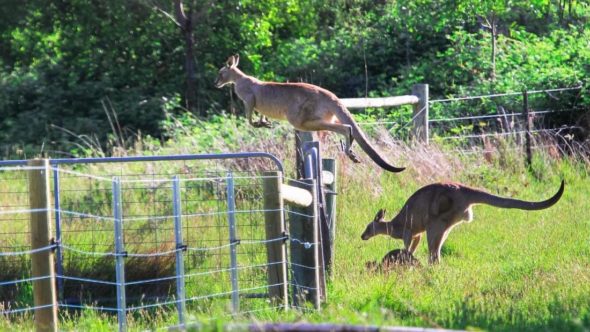
Australian federal legislation supposedly protects native wildlife – making it an offence to kill, buy, sell or possess endemic fauna. However, state management plans allow for the issuing of ‘licenses to harm kangaroos’ for both the commercial kangaroo meat trade and ‘k-leather’ industry. Kangaroo leather is used in high-end fashion and some professional football boot brands such as ADIDAS, Nike and Puma. Kangaroos are also killed in non-commercial ‘culls’ to reduce the ‘significant impact that over-abundant kangaroo populations have on agriculture’.4Department of Agriculture, Water and the Environment (DAWE). ‘Wild harvest of kangaroos and wallabies’. Available at https://www.environment.gov.au/biodiversity/wildlife-trade/natives [Accessed 03 April 2020].
Viva! has been given two primary defences by the industry for the killing of kangaroos. These are:
- Kangaroos are a major wheat crop pest and
- Kangaroos compete with sheep/cattle for resources
Both are unfounded.
A four-year study of grey kangaroos in Western Australia by the Commonwealth Scientific & Industrial Research Organisation (CSIRO), found that 95 per cent of wheat crops are never visited by kangaroos and that few kangaroos wander more than 400 metres from their home range in the bush.5Arnold, G., 1990. ‘Can Kangaroos Survive in the Wheatbelt?’. WA Journal of Agriculture 31 pp. 1090. The study concluded that kangaroos have virtually no impact on the country’s crops and recommended that farmers who have natural bush land on their property should encourage its growth to help native vegetation thrive in order to feed kangaroos.
Furthermore, most commercial kangaroo killing takes place in areas where they are not widely seen as a problem to crop growers – largely because these areas have been turned over to grazing1Elle, B., 2018. ‘The Largest Killing of Land-Based Wildlife in the World: Australia’s Kangaroo Culls’. Medium 29 March. Available at https://medium.com/invironment/the-largest-killing-of-land-based-wildlife-in-the-world-australias-kangaroo-culls-6c81fe8552ec [Accessed 07 April 2020]. and account for only 10 per cent of Australia’s meat production.6Wilson, M., 1999. The Kangaroo Betrayed: World’s Largest Wildlife Slaughter. Australia: Australian Wildlife Protection.
Yet farmers and the Australian government regularly refer to kangaroos as pests. Dr Arnold responds:
“Pests is an emotive word. It conjures up visions of animals destroying crops. I can think of no situations where this is likely to be true for kangaroos”.5Arnold, G., 1990. ‘Can Kangaroos Survive in the Wheatbelt?’. WA Journal of Agriculture 31 pp. 1090.
The second main reason given for slaughtering kangaroos is that they compete for resources with cattle and sheep. A six year study by Dr Steven McLeod at the University of New South Wales7McLeod, S., 1996. ‘The Foraging Behaviour of the Arid Zone Herbivores the Red Kangaroo (Macropus rufus) and the Sheep (Ovis aries) and its Role on Their Competitive Interaction, Populations Dynamics and Life-History Strategies’. A thesis submitted for the degree of Doctor of Philosophy, University of New South Wales, February. thoroughly examines whether the presence of red kangaroos negatively impacts on sheep. He finds that:
“There was no evidence of a competitive effect of red kangaroos on sheep”.
This was true even in drought conditions. The study concluded that red kangaroos do not affect the body mass, wool growth, reproductive output of sheep or the growth and survivor-ship of lambs. In fact, it was found that red kangaroos consistently avoid areas used by sheep and that sheep have a negative impact on kangaroos!
Further, field researcher Ingrid White who studied kangaroo behaviour at UNSW Arid Zone Research Station Fowlers gap, Broken Hill, states:
“Like several other researchers before me, working in the same study area located on a commercial sheep station in the outback of New South Wales and working under real conditions, in real paddocks and with real stocking rates, I found little evidence for detrimental effects of kangaroo on the domestic sheep or vegetation. And this, despite the kangaroos not having been culled as a ‘pest’ species for more than 30 years – and the kangaroos equalling or surpassing the numbers of sheep stocked on the station”.6Wilson, M., 1999. The Kangaroo Betrayed: World’s Largest Wildlife Slaughter. Australia: Australian Wildlife Protection.
The use of kangaroo meat for human consumption has only been legal in South Australia since 1980. In other states, the sale of kangaroo meat other than for ‘pet’ food was not allowed until 1993, when it was legalised in New South Wales. At the same time, mutual recognition legislation came into being, which allows products permitted for sale in one state to be sold in every state, so that kangaroo meat became nationally available from that time.
Otherwise known as ‘commercial harvesting’, the killing of kangaroos is currently carried out for trade and export in five states – New South Wales (NSW), Queensland (QLD), South Australia (SA), Western Australia (WA) and, to a lesser extent Victoria (VIC) – for ‘pet’ food rather than human consumption – and two species of wallaby (Bennett’s wallaby and Tasmanian Pademelon) are targeted in Tasmania (TAS) for meat in the domestic market and fur exports.
The kangaroo meat industry claims that these animals need to be killed, keeping their numbers in check, to balance Australia’s ecology in the absence of natural predators, such as dingoes.1Berlin, J., 2019. ‘Australia’s Beloved Kangaroos are now Controversial Pests’. National Geographic February. Available at https://www.nationalgeographic.com/magazine/2019/02/australia-kangaroo-beloved-symbol-becomes-pest/ [Accessed 07 April 2020]. Shooters invariably target the biggest, healthiest animals in a mob and this could cause long-term damage to the species.
The supposed aim of ‘culling wildlife’ is to reduce the size of a population and involves the killing of entire family groups – including the old, sick, diseased and lame. However, in the case of kangaroo slaughter, it is generally the largest and fittest animals who are shot (often males) as they provide more meat and skin. This undermines the process of natural selection, as although a population will try to breed quickly to regain numbers, the less fit individuals reproduce, leading to a genetically inferior population. This situation is worsened in severe drought conditions when, on top of the millions of kangaroos that die naturally, the kangaroo industry wipes out the very individuals who are most able to survive the extreme conditions.2Gellatley, J. 2006. Under fire, A Viva! Report on The Killing of Kangaroos for Meat and Skin. Bristol: Viva!.
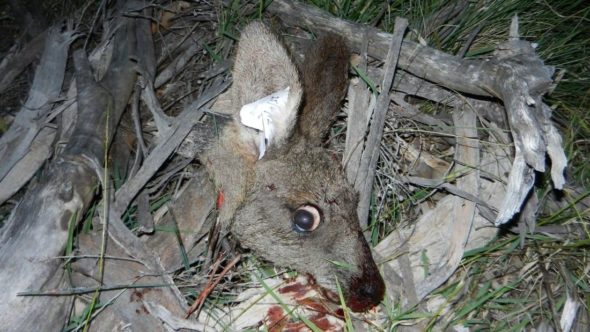
According to the late Dr Peter Rawlinson, zoologist at La Trobe University in Melbourne: “Kangaroo culling programs completely disregard the age and sex structure of herds and for this reason cannot be taken seriously…. Professional hunters shoot mainly large adult males because these animals earn them the most money”.3Rawlinson, P., 1983. ‘The Land’ in Australian Wildlife Protection Council, 2015. A Voice for Wildlife March. Available at https://awpc.org.au/wp/wp-content/uploads/2015/03/March-2015-News-Letter.pdf [Accessed 07 April 2020].
All state management plans and wildlife trade operations require kangaroo kill methods to comply with the National Code of Practice for the Humane Shooting of Kangaroos and Wallies for Commercial Purposes (The Code)4Natural Resource Management Ministerial Council (NRMMC), 2020. ‘National Code of Practice for the Humane Shooting of Kangaroos and Wallabies for Commercial Purposes’. Available at https://agrifutures.com.au/wp-content/uploads/2020/11/20-126-digital.pdf [Accessed 10 January 2024]. – but it’s considered more a guideline for shooters to follow rather than the law. It implies that kangaroos are killed by licensed professional marksmen that are well trained with an in-depth understanding of the code of conduct.
An RSPCA investigation however, reported that 90 per cent of shooters in the industry are part-time, some are ‘unskilled in shooting technique’ and are ‘the main contributors to inhumanely shot kangaroos”.5Pople, T. and Grigg, G., 1999. ‘Commercial Harvesting of Kangaroos in Australia’. Environment Australian April. Available at https://www.environment.gov.au/resource/commercial-harvesting-kangaroos-australia [Accessed 06 April 2020].
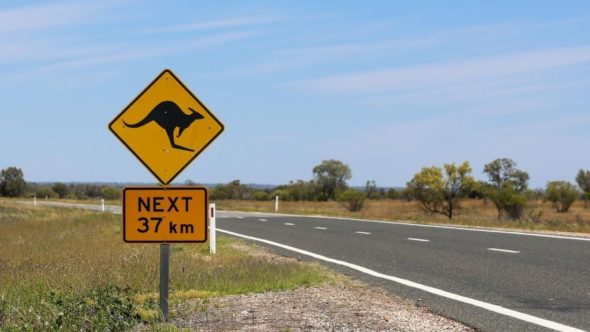
It is a bloody industry, graphically portrayed in the film, Kangaroo: A Love-Hate Story.6McIntyre, M. and McIntyre, K., 2017. Kangaroo: A Love-Hate Relationship [DVD]. Australia: Hopping Pictures. The documentary opens like a typical horror movie, with suspense-building, clandestine, grainy black and white footage depicting the final moments of some of Australia’s beloved national icons, or belligerent pests, depending upon who you ask.
On the one hand, kangaroos are considered among the world’s most iconic and charismatic species and feature on Australia’s coat of arms, its commercial airline and on national currency. They appear in their own TV shows, have a bunch of sports teams named after them and in many ways have come to symbolise what it means to be Australian by the international community. On the other hand, they are treated as disposable commodities by the kangaroo industry who measure their worth in dollars for their meat and fur; the Australian government label them a nuisance, blame them for destroying livestock pastures and some even believe kangaroos ‘should be eliminated wholesale’.6McIntyre, M. and McIntyre, K., 2017. Kangaroo: A Love-Hate Relationship [DVD]. Australia: Hopping Pictures.
Killing tactics and The Code
Night after night, kangaroo shooters crisscross the vast Australian outback, causing erosion and trampling native vegetation with the wheels of their four-track vehicles. Powerful searchlights illuminate their prey as they take aim and fire. Supposedly the animals are shot once in the head, as per the ‘humane’ guidelines provided by The Code,4Natural Resource Management Ministerial Council (NRMMC), 1998. ‘National Code of Practice for the Humane Shooting of Kangaroos and Wallabies for Commercial Purposes’. Available at https://www.environment.gov.au/system/files/resources/8ae26c87-fb7c-4ddc-b5df-02039cf1483e/files/code-conduct-commercial.pdf [Accessed 06 April 2020]. but a large proportion are miss-shot – hit in the throat or neck – leaving them struggling and still conscious when dragged to the truck and hung on a rusty hook. From time to time, the shooter stops to gut the kangaroos, chopping off their heads, limbs and tails and discarding their remains which feed feral animals such as foxes, further skewing Australia’s fragile ecology.5Pople, T. and Grigg, G., 1999. ‘Commercial Harvesting of Kangaroos in Australia’. Environment Australian April. Available at https://www.environment.gov.au/resource/commercial-harvesting-kangaroos-australia [Accessed 06 April 2020].
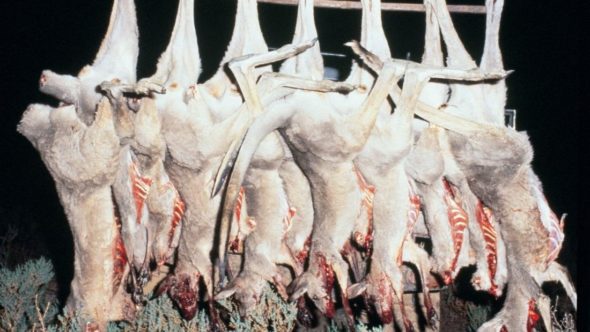
Carcasses are delivered to a chiller, usually at a local town depot, to reduce their temperature and stop them from rotting. From there, they are taken to a processing plant. Their skins are pulled off and sent to a tannery to make leather while the body is butchered for meat. What’s left goes into making cheap fertilisers.
Relative to their body size, kangaroos have small heads, which makes them a difficult target – especially when dazzled by searchlights and hopping away in fear. The Australian RSPCA released a report in 1985 which concluded that at least 100,000 adult kangaroos each year are not killed ‘humanely’, but admitted that the number was a conservative estimate as it took no account of the unquantifiable number of injured animals who escape only to die slow, agonising deaths from their injuries in the field.7Boom, K. and Ben-Ami, D., 2010. ‘Shooting Our Wildlife: An analysis of the law and policy governing the killing of kangaroos’. Research Report, THINKK. Sydney: University of Technology. Available at https://core.ac.uk/download/pdf/30681761.pdf [Accessed 06 April 2020].
In 2002, the percentage of head shots was up by almost 10 per cent but at least 120,000 animals were still estimated to be shot in the body. The survey only referred to those animals who they were able to analyse in chillers and not those who had escaped to die in the bush.7Boom, K. and Ben-Ami, D., 2010. ‘Shooting Our Wildlife: An analysis of the law and policy governing the killing of kangaroos’. Research Report, THINKK. Sydney: University of Technology. Available at https://core.ac.uk/download/pdf/30681761.pdf [Accessed 06 April 2020].
Quotas and the number of kangaroos killed
In 2021, the estimated population of kangaroos in the surveyed areas of NSW, QLD, SA and WA stood at just over 30.5 million, with around 4.5 million (sustainable and special quotas combined) earmarked for slaughter in 2022 – more than 14 per cent of the estimated population.8Department of the Environment and Energy (DEE), 2022. ‘Macropod quotas and harvest for commercial harvest areas in NSW, QLD, SA and WA – 2022′. Available at https://www.environment.gov.au/system/files/pages/ee20f301-6c6c-44e4-aa24-62a32d412de5/files/kangaroo-statistics-states-2022.pdf [Accessed 10 January 2024]. Despite a quota of 7.1 million being set in 2018, only 1,565,140 animals were killed – (19 per cent of the quota). This may have been due, in part, to negative publicity the industry has faced over serious animal welfare concerns.1Berlin, J., 2019. ‘Australia’s Beloved Kangaroos are now Controversial Pests’. National Geographic February. Available at https://www.nationalgeographic.com/magazine/2019/02/australia-kangaroo-beloved-symbol-becomes-pest/ [Accessed 07 April 2020].
Although introduced as a ‘land management tool’, the government quota only considers estimated population sizes. The problem with this estimation is that it includes animals surveyed in protected areas, such as national parks, that generally have more kangaroos than farmlands rather than any evidence of land being under stress.9Mjadwesch, R., 2011. ‘Kangaroos at Risk’. Available at https://www.kangaroosatrisk.net [Accessed 07 April 2020]. It also only surveys the four main targeted species in the commercial harvest zones – reds, eastern greys, western greys and the common wallaroo10Department of Agriculture, Water and the Environment (DAWE), ‘Wild harvest of kangaroos and wallabies’. Available at https://www.environment.gov.au/biodiversity/wildlife-trade/natives [Accessed 03 April 2020]. – and are not representative of the total number of animals in the country or the numbers that die as a result of non-commercial ‘culls’.
The inaccuracy of these baseline numbers is another area Kangroo: A Love-Hate Story explores.6McIntyre, M. and McIntyre, K., 2017. Kangaroo: A Love-Hate Relationship [DVD]. Australia: Hopping Pictures. It’s a seemingly complicated algorithm that makes no sense, even to the ‘expert’ trying to explain how it works. Numbers are vastly exaggerated in order to preserve the industry and therefore make it self-sustaining. Ultimately, the government faces little scrutiny when it comes to data and the management of ‘harvesting zones’.
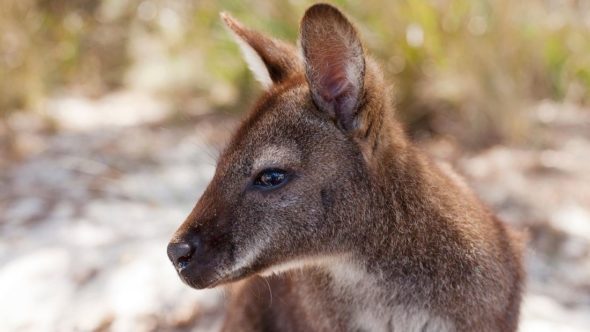
The Tasmanian wallaby kill figures, for example, indicate that more than 600,000 animals were killed between 2003 and 2013 for non-commercial purposes – averaging 60,000 animals a year. This compares with commercial killings of anything from 300,000 to 1,000,0000 annually, according to conflicting unpublished WMB data in Wildlife Trade Operation proposals from Osmaston Meats11Osmaston Meats, 2014. ‘Draft Proposal for Wildlife Trade Operation for the Export of Bennett’s Wallaby and Rufous Pademelon Meat, Skins and Fur from Tasmania’. Available at https://www.environment.gov.au/system/files/pages/79029b2e-1080-4045-9c80-83ca962d1f49/files/osmaston-meats-export-proposal.pdf [Accessed 07 April 2020]. and Lenah Game Meats.12Lenah Game Meat Ltd., 2017. ‘Proposal for the Commercial Harvest and Export of Products Obtained from Wallabies in Tasmania’. Available at https://www.environment.gov.au/system/files/pages/c2cc4674-64be-4afa-90e6-ff4957d98d0d/files/lenah-game-meats-wto-2018.pdf [Accessed 07 April 2020].
These numbers do not account for those animals shot illegally, the joeys killed as waste-products or the more than 16,000 killed in vehicle-animal collisions reported each year. It follows that estimates are likely to be significantly under reported.
The general trend has seen quotas steadily rise since the 1970s. Even in 1982 and 1983, during a severe drought which caused kangaroo numbers to drop to 11 million, the kill quota was set at more than three million. As a ‘boom-and-bust’ species, kangaroos naturally increase their numbers when times are good and die in equally large numbers when environmental factors become harsh.13Wahlquist, C., 2019. ‘Australia’s kangaroo meat trade could be the most sustainable in the world, despite welfare concerns’. The Guardian 12 October. Available at https://www.theguardian.com/world/2019/oct/13/australias-kangaroo-cull-humane-and-sustainable-or-exercise-in-cruelty [Accessed 07 April 2020]. The annual slaughter of millions of kangaroos undermines the process of natural selection and threatens kangaroos’ survival – especially when the healthiest of the species are targeted simply because they are more profitable.
For Dr Gunn:14Wilson, M., 1999. The Kangaroo Betrayed: World’s Largest Wildlife Slaughter. Australia: Australian Wildlife Protection. “The evidence is indisputable and, if left to continue, has the potential to result in reduced genetic variability, lower reproductive efficiency and a radical reduction in the population density below sustainable levels in certain regions of the country when associated with habitat destruction or seasonal conditions such as droughts”. Weaker, unfit and unstable populations emerge, destroying the social order of a kangaroo mob and its inherited genetic strength.
“During the 2000s, Australia faced one of its worst droughts on record, causing kangaroo numbers to drop to 23.8 million. When the drought broke, around 2010, more food became available, and their numbers began to grow again, to 2017’s estimate of nearly 50 million”.15York, C. and Bale, R., 2017. ‘Australians Hunt Kangaroos Commercially. Does It Make Sense?’. National Geographic 21 November. Available at https://www.nationalgeographic.com/news/2017/11/wildlife-watch-kangaroo-hunting-controversy-australia/ [Accessed 07 April 2020]. Then came the extreme drought of 2018, when “the NSW government introduced new regulations to make it easier for landholders to obtain a licence to shoot kangaroos on their property, and easier for multiple shooters to operate at once. In effect, to allow shooting parties”.13Wahlquist, C., 2019. ‘Australia’s kangaroo meat trade could be the most sustainable in the world, despite welfare concerns’. The Guardian 12 October. Available at https://www.theguardian.com/world/2019/oct/13/australias-kangaroo-cull-humane-and-sustainable-or-exercise-in-cruelty [Accessed 07 April 2020].
Commercial harvesting of kangaroos may have originally been established for the purposes of ‘damage mitigation’ and ‘population control’ but it has subsequently been recognised by state governments that the industry now exists in its own right, harvesting a ‘renewable natural resource’ and is openly promoted as a ‘source of economic benefits for all Australians’.16Wilson, M., 2000. ‘Australia ‘s Gold Medal for Hypocrisy’. Available at http://www.animalsagenda.org/medal_for_hypocrisy.htm [Accessed 08 April 2020].
Fate of the Joeys
Mother kangaroos often have a joey in pouch and one at foot – neither of which can survive without her. The Code states that only the joey in pouch must be killed along with its mother.4Natural Resource Management Ministerial Council (NRMMC), 1998. ‘National Code of Practice for the Humane Shooting of Kangaroos and Wallabies for Commercial Purposes’. Available at https://www.environment.gov.au/system/files/resources/8ae26c87-fb7c-4ddc-b5df-02039cf1483e/files/code-conduct-commercial.pdf [Accessed 06 April 2020]. The preferred method for doing this is decapitation with a sharp instrument for very small, hairless joeys, or a properly executed heavy blow to destroy the brain of larger young.4Natural Resource Management Ministerial Council (NRMMC), 1998. ‘National Code of Practice for the Humane Shooting of Kangaroos and Wallabies for Commercial Purposes’. Available at https://www.environment.gov.au/system/files/resources/8ae26c87-fb7c-4ddc-b5df-02039cf1483e/files/code-conduct-commercial.pdf [Accessed 06 April 2020]. The reality is, after being pulled from their dead mothers’ pouches these young joeys are either stamped on, clubbed, shot or simply left on the ground to die.
There are no guidelines for how to handle at-foot joeys, who are also completely dependent upon their mothers for milk, warmth and protection. They often hop away into the night, invariably to die of starvation, predation, cold or neglect.
The industry and its customers refuse to discuss the plight of joeys, knowing that the public is horrified by the senseless killing of these baby animals. It is believed that over a ten-year average, 800,000 dependent joeys are killed as collateral damage of the kangaroo industry every year.17Ben-Ami, D., Boom, K., Boronyak, L., Townend, C., Ramp, D., Croft, D. and Bekoff, M., 2014. ‘The welfare ethics of the commercial killing of free ranging kangaroos: an evaluation of the benefits and costs of the industry’. Animal Welfare 23 pp 1-10. Available at https://www.researchgate.net/publication/259603520_The_welfare_ethics_of_the_commercial_killing_of_free-ranging_kangaroos_An_evaluation_of_the_benefits_and_costs_of_the_industry [Accessed 08 April 2020].

Kangaroos harbour a range of parasitic bacterial, fungal and viral diseases – many of which increase with stress and crowding. Speare et al1Speare, R., Donovan, J., Thomas, A. and Speare, P., 1989. ‘Diseases in Free-ranging Macropodidae’ in Grigg, G., Jarman, P. and Hume, I. (eds.), 1989. Kangaroos, Wallabies and Rat-Kangaroos. Sydney: Surrey Beatty & Sons. indicate that ‘both species of grey kangaroos may be infected with 30,000 nematodes from 20 different species’. Many of these are unlikely to be detected in the meat unless gross lesions are apparent, or samples are taken for testing. New species of microscopic worms have been identified through laboratory tests simply because individuals have suffered mysterious illnesses as a result of eating infected meat.2Obendorf, D. ‘Disease in Kangaroo Meat’ in Staker, L. (ed.), 2014. Macropod Husbandry, Healthcare and Medicinals – Volume 2. Available at https://books.google.co.uk/books?id=37e1AwAAQBAJ [Accessed 06 April 2020].
In Australia, Toxoplasmosis and Salmonellosis are two infections with public health significance directly related to the handling, processing and consumption of kangaroo meat.2Obendorf, D. ‘Disease in Kangaroo Meat’ in Staker, L. (ed.), 2014. Macropod Husbandry, Healthcare and Medicinals – Volume 2. Available at https://books.google.co.uk/books?id=37e1AwAAQBAJ [Accessed 06 April 2020]. So-called game meats, like kangaroo, carry dangerously high levels of Salmonella and E.coli. Due to the unhygienic nature in which animals are killed and their carcasses transported, on rusty hooks strapped to the back of utility vehicles and stored in refrigerated containers for indeterminate lengths of time, consumers are at risk of contracting Toxoplasmosis. This can result in foetal death or birth defects in the babies of affected women.3Burke, K., 2009. ‘Hygiene threatens kangaroo meat industry’. Sydney Morning Herald 18 November 2009. Available at https://www.smh.com.au/environment/hygiene-threatens-kangaroo-meat-industry-20091117-ikf6.html [Accessed 06 April 2020].
For Dr Desmond Sibraa3Burke, K., 2009. ‘Hygiene threatens kangaroo meat industry’. Sydney Morning Herald 18 November 2009. Available at https://www.smh.com.au/environment/hygiene-threatens-kangaroo-meat-industry-20091117-ikf6.html [Accessed 06 April 2020]. “there is a big difference between animals slaughtered in an abattoir with an inspector present and a kangaroo shot in the bush with dust and blowflies”. To rid meat of Salmonella, the deep muscle must reach at least 60 degrees during cooking but that toughens it up and so the tradition of serving kangaroo rare to avoid this means it is unlikely to reach this temperature.3Burke, K., 2009. ‘Hygiene threatens kangaroo meat industry’. Sydney Morning Herald 18 November 2009. Available at https://www.smh.com.au/environment/hygiene-threatens-kangaroo-meat-industry-20091117-ikf6.html [Accessed 06 April 2020].
The risk to human health from consuming kangaroo meat is so great that in 2008 Russia placed a temporary ban on imports, after a consignment was found to be contaminated with bacterium that the Australian Quarantine and Inspection Service had no test to detect.3Burke, K., 2009. ‘Hygiene threatens kangaroo meat industry’. Sydney Morning Herald 18 November 2009. Available at https://www.smh.com.au/environment/hygiene-threatens-kangaroo-meat-industry-20091117-ikf6.html [Accessed 06 April 2020]. It happened again in 2014, due to unacceptable levels of E.coli.4Tapp, V., 2014. ‘Russia bans kangaroo meat due to unacceptable levels of E.coli’. ABC News 18 August. Available at https://www.abc.net.au/news/rural/2014-08-18/kangaroo-meat-ban/5677656 [Accessed 06 April 2020]. Dog treats made from kangaroo meat were also withdrawn in 2014 due to Salmonella contamination.5News Desk, 2014. ‘Kangaroo Meat Pet Treats Recalled for Potential Salmonella Risk’. Food Safety News 31 December. Available at https://www.foodsafetynews.com/2014/12/jump-your-bones-kangaroo-meat-pet-treats-recalled-for-salmonella-risk/#.VRA9_Y6sXpp [Accessed 06 April 2020].
In targeting the healthiest and strongest animals, it’s likely that the kangaroo industry is, in part, responsible for increased disease levels in kangaroos due to weakening the genetic pool. This not only poses a direct threat to Australia’s biodiversity but also the state of public health globally.
Save the Kangaroo campaign

Viva! have been actively campaigning against the annual massacre of kangaroos since 1994, when our attention was drawn to a new product range on Tesco’s meat counter. In discovering the barbaric nature in which these animals are killed we were determined to expose it. We obtained footage of a kangaroo shooter in action and his savagery shocked everyone who saw it.
In the footage, he shoots animals in their throats and legs before slashing them open to insert a hook and hauls them on to the back of his vehicle, still gasping in agony. Large, still-conscious males were dragged up by their testicles and when females were shot, the first action of the killer was to search their pouches for babies. Having found one, he threw it to the ground and stamped on it, grinding his heel on the joey’s head. He walked away, leaving it writhing. Obviously, there is no justification for this wildlife massacre and our research revealed the excuses offered by the Australian government were untrue.
Determined to stop this cruelty, we targeted Tesco by persistently campaigning for two years, revealing the reality of the kangaroo trade to their customers. We printed specific materials, organised hundreds of local groups to demonstrate outside their stores and supplied information to the media. The culmination was a double page spread in the News of the World on kangaroo killing; Tesco dropped the trade four days later. That was 26 September 1997. Shortly after, Somerfield also dropped sales, cancelling an entire frozen food range, and Sainsbury’s followed a year later.
Our founder, Juliet Gellatley, was invited to Australia three times to do media tours, and spoke on almost 100 radio programmes and every major TV outlet, making a documentary for 60 Minutes, with ABC. We worked closely with Maryland Wilson of the Australian Wildlife Protection Council and groups such as Animal Liberation, as well as politicians such as Richard Jones, Member of the Legislative Council, Parliament of New South Wales.
In 2002, we shifted our focus to the leather industry in a campaign Killing for Kicks and after four years of determined campaigning, we were able to announce that David Beckham had decided to ditch his controversial kangaroo skin football boots in favour of synthetics. His new boots – Adidas Cardinal Red/Silver Absolutes, which he helped to design, were instead made from high-tech synthetic materials and promoted as the ‘most accurate, lightest and powerful’ Predators ever, positively reinforcing our Save the Kangaroo campaign.
Despite our early successes, kangaroo meat began to make a resurgence in British supermarkets around 2013 when budget chain Lidl introduced a promotional burger range. We launched a continuing campaign calling for an end to its sale of kangaroo meat, which secured major press coverage in The Sun newspaper. Iceland also decided to hop on the wildlife meat bandwagon in 2015 with the introduction of so-called ‘exotic meats’ – including kangaroo.
Another supermarket chain, Morrisons, was also slammed in the national media for putting consumers at risk by selling kangaroo steaks and recommending the meat be cooked ‘medium rare’. After a deluge of emails from Viva! supporters Morrisons too dumped the range, insisting the steaks were a ‘limited time promotion’.
In recent years, we’ve seen kangaroo meat return to both Tesco and Sainsbury’s but our fast action to condemn them publicly led to both chains once again dropping the sales. Only Lidl and Iceland persisted so we continued our campaigning and in 2018, claimed a double victory as Iceland announced all lines containing kangaroo meat had been removed from sale in response to feedback from customers. They were closely followed by Lidl after we forwarded proof of significant animal welfare issues and health concerns to Lidl UK’s Managing Director. As of June 2018, kangaroo meat products were removed from all UK supermarkets.
These successes were shortly followed by companion animal retailer, Pets at Home, discontinuing sales of dog treats in response to our appeal. Their CEO, Peter Pritchard, responded positively, confirming that the treats did not meet their ethical standards. We agreed.
- Under fire, A Viva! Report on The Killing of Kangaroos for Meat and Skin, by Juliet Gellatley. Read now.
Killing for Kicks

Mum’s Gone to Iceland (in a box)





